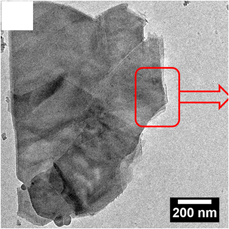Crossref Citations
This article has been cited by the following publications. This list is generated based on data provided by
Crossref.
Liang, Ju-Mei
Zhang, Li-Juan
XiLi, De-Ge
and
Kang, Jing
2020.
Research progress on tin-based anode materials for sodium ion batteries.
Rare Metals,
Vol. 39,
Issue. 9,
p.
1005.
Illa, Mani Pujitha
Pathak, Anil D
Sharma, Chandra S.
and
Khandelwal, Mudrika
2020.
Bacterial Cellulose–Polyaniline Composite Derived Hierarchical Nitrogen-Doped Porous Carbon Nanofibers as Anode for High-Rate Lithium-Ion Batteries.
ACS Applied Energy Materials,
Vol. 3,
Issue. 9,
p.
8676.
Yue, Lu
Xu, Wanyin
Li, Kai
Xiao, Liwei
Feng, Chengjie
Si, Xinyang
Cheng, Kun
Zhang, Feng
Hou, Guihua
and
Zhang, Wenhui
2021.
3D nitrogen and sulfur equilibrium co-doping hollow carbon nanosheets as Na-ion battery anode with ultralong cycle life and superior rate capability.
Applied Surface Science,
Vol. 546,
Issue. ,
p.
149168.
Tian, Jinjun
Xue, Yan
Wu, Keliang
Guo, Meng
and
Zeng, Xiancai
2021.
TPAOH‐Assisted Preparation of Hexagonal Ni(OH)2 Nanoplates for Supercapacitors**.
ChemistrySelect,
Vol. 6,
Issue. 48,
p.
13975.
Jaramillo-Quintero, Oscar A.
Barrera-Peralta, Royer V.
Baron-Jaimes, Agustin
Miranda-Gamboa, Ramses A.
and
Rincon, Marina E.
2021.
Sb2O3 nanoparticles anchored on N-doped graphene nanoribbons as improved anode for sodium-ion batteries.
RSC Advances,
Vol. 11,
Issue. 50,
p.
31566.
ZHANG, Xuehu
ZHANG, Jian
HAN, Beibei
WANG, Kun
XU, Guiying
WANG, Yingxin
AN, Baigang
JU, Dongying
CHAI, Maorong
and
ZHOU, Weimin
2021.
Fabrications and Na<sup>+</sup> Storage Characteristics of Nitrogen-doped Biomass-derived Carbon Materials.
Electrochemistry,
Vol. 89,
Issue. 4,
p.
382.
Muruganantham, Rasu
Chiang, Yu-Xuan
and
Liu, Wei-Ren
2022.
Nitrogen-doped hard carbon derived from agro-food waste of mushroom bags biomass as an anode material for sodium-ion batteries.
MRS Energy & Sustainability,
Vol. 9,
Issue. 2,
p.
313.
Singh, Yogesh
Parmar, Rahul
Mamta
Rani, Sanju
Kumar, Manoj
Maurya, Kamlesh Kumar
and
Singh, Vidya Nand
2022.
Na ion batteries: An India centric review.
Heliyon,
Vol. 8,
Issue. 8,
p.
e10013.
Jauja-Ccana, Victor Raúl
La-Torre-Riveros, Lyda
Cordova-Huaman, Allison
Huayta, Giancarlos
Manfredy, Luigi
Naupa, Alexander
Isaacs, Mauricio
and
La Rosa-Toro, Adolfo
2023.
Review—Rational Design of Nitrogen-doped Graphene as Anode Material for Lithium-ion Batteries.
Journal of The Electrochemical Society,
Vol. 170,
Issue. 4,
p.
040525.
Thangaraj, Baskar
Solomon, Pravin Raj
and
Hassan, Jamal
2023.
Nanocarbon in Sodium‐ion Batteries – A Review. Part 1: Zero‐dimensional Carbon Dots.
ChemBioEng Reviews,
Vol. 10,
Issue. 5,
p.
628.
Ding, Doudou
Gao, Fa
Wu, Yidan
Li, Yu
Li, Tao
and
Ren, Baozeng
2023.
Preparation and electrochemical application of melamine resin-based carbon materials.
Journal of Porous Materials,
Vol. 30,
Issue. 4,
p.
1319.
Sviridenko, D. G.
Arysheva, S. P.
Suslov, A. A.
Ivankin, N. G.
and
Petrov, K. V.
2024.
Effectiveness of PhosAgro NPK and Gumiton under cultivating potatoes in radioactive soil contamination conditions.
Вестник российской сельскохозяйственной науки,
p.
48.
Li, Yinuo
Li, Yuhang
Jiang, Yulin
Peng, Yanan
Xiao, Chuxuan
Huang, Ling
Li, Xiaohui
Xu, Ruihan
Song, Luying
Du, Zhu
Sun, Hang
Wen, Xia
and
Shi, Jianping
2024.
Nitrogen and sulfur co-doping mesoporous carbon for high-rate and long-cycle sodium-ion storage.
Nano Research,
Vol. 18,
Issue. 6,
p.
94907462.
Jegan, Lekshmi
Nair, Neeraja
Nair, Shantikumar
Baskar, Senthilkumar
and
Santhanagopalan, Dhamodaran
2025.
Electrochemical Energy Storage Technologies Beyond LI-ION Batteries.
p.
105.


